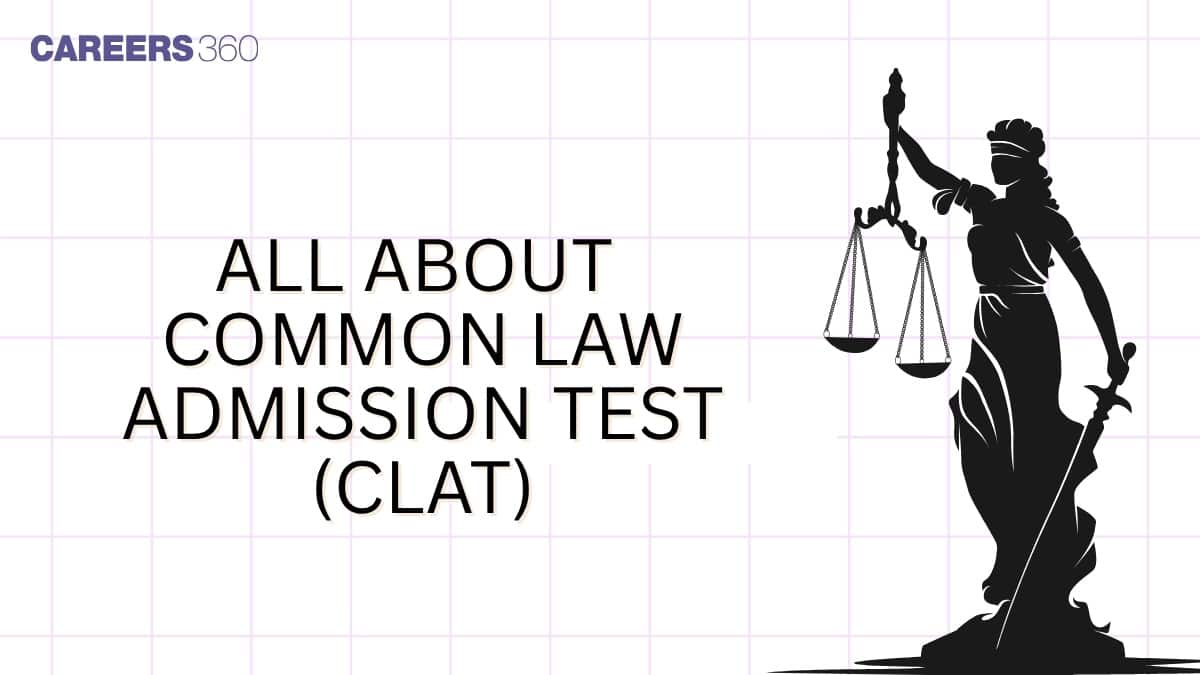Amity University-Noida Law Admissions 2026
Among top 100 Universities Globally in the Times Higher Education (THE) Interdisciplinary Science Rankings 2026
The Common Law Admission Test, commonly referred to as CLAT, is a national-level law entrance examination in India. The CLAT exam is considered a gateway to prestigious national law universities (NLUs) and other prominent law schools in India. Every year, over 60,000 candidates take the CLAT exam for 5-year integrated LLB courses and LLM courses.
This Story also Contains

The CLAT exam is conducted by the Consortium of National Law Universities (NLUs). The CLAT exam date 2026 is December 7, 2025. The scores of CLAT are accepted by 24 NLUs, an off-campus of GNLU Gandhinagar in Silvassa, IIULER Goa and over 60 affilated law schools across the country.
Full name | Common Law Admission Test |
Exam date | First week of December every year |
Conducting body | Consortium of National Law Universities (CNLU) |
Courses offered | 5-year integrated LLB and LLM courses |
Participating NLUs | 24 |
CLAT-affiliated colleges | 60+ |
Number of test takers for CLAT | 60,000+ |
The acceptability of CLAT goes beyond LLB and LLM admissions. It can also be used for employment in Public Sector Undertakings (PSUs) and the Indian Army. In short, CLAT has multiple objectives.
Act as a screening test for the 5-year integrated LLB and LLM courses offered by NLUs and affiliated law schools
Jobs offered by PSUs based on CLAT PG scores
Since CLAT is conducted at two levels - CLAT UG and CLAT PG, candidates applying for the exam should meet the following conditions.
Candidates must meet the CLAT eligibility criteria before filling up the application form. The eligibility criteria vary depending on the course selection. The details of course-wise eligibility criteria are explained below.
Candidate must have passed class 12th from a recognised board with at least 45% marks (40% in the case of SC/ST candidates).
Among top 100 Universities Globally in the Times Higher Education (THE) Interdisciplinary Science Rankings 2026
Ranked #18 amongst Institutions in India by NIRF | Ranked #1 in India for Academic Reputation by QS Rankings | 16 LPA Highest CTC
Candidates must have completed an LLB course (3-year LLB or 5-year LLB) with at least 50% marks (45% in the case of SC/ST candidates) from a recognised university.
Many students wonder if CLAT scores can be used for getting admission to 3-year LLB courses. CLAT has been primarily designed to test the skills at the Class 12th level, keeping in mind the standard of applicants for the 5-year LLB. So, the exam cannot be adopted for the 3-year LLB where applicants are graduates.
CLAT Registration and Fees
The consortium releases the CLAT application form in the first week of August every year. The CLAT registration website is consortiumofnlus.ac.in. Candidates need to fill in personal and communication details, exam centre preferences, reservation status and NLU preferences while filling out the application form for the CLAT exam.
The CLAT registration fee is Rs. 4,000 for General/OBC/PWD/NRI candidates and Rs. 3,500 for SC/ST/BPL candidates. The CLAT registration fee is generally much higher than many other law entrance exams and, therefore, is often seen as a barrier by underprivileged candidates willing to study in NLUs.
Reading, critical thinking and analytical skills are considered essential for a successful career in Law. The CLAT syllabus is designed to test these skills. Accordingly, the CLAT syllabus has five subjects.
English and Comprehension
Legal Aptitude
Logical Reasoning
Maths
General Knowledge and Current Affairs
Unlike many other law entrance exams, the CLAT UG syllabus is vast, and as a result, the question paper turns very lengthy. 120 multiple-choice type questions are asked from comprehension-based passages and thus require a lot of reading and analysis of paragraphs.
Since CLAT is not conducted in vernacular languages, English becomes a dominant factor in the entrance exam. This also leads to the criticism that CLAT favours candidates who have previously studied in the English medium. The state board students or those who study in regional languages remain at a typical disadvantage as they have to go the extra mile by working on the English language and vocabulary.
The CLAT LLM syllabus covers almost every aspect of the LLB course. The subjects in CLAT LLM are taken from the subjects of LLB courses. Candidates are expected to demonstrate a decent understanding of various laws, constitutions, and current legal affairs. The CLAT LLM question paper, too, has comprehension-based questions. The topics covered in CLAT LLM are mentioned below;
Constitutional Law
Jurisprudence
Administrative Law
Law of Contract
Torts
Family Law
Criminal Law
Property Law
Company Law
Public International Law
Tax Law
Environmental Law
Labour & Industrial Law
The CLAT exam is accepted by all National Law Universities (NLUs) except NLU Delhi and NLU Meghalaya. There are 24 NLUs and GNLU’s off-campus that are part of the CLAT consortium and participate in the admission process. The list of such NLUs is given below.
S No. | States | NLUs |
|---|---|---|
1 | Karnataka | NLSIU Bengaluru |
2 | Telangana | NALSAR Hyderabad |
3 | West Bengal | WBNUJS Kolkata |
4 | Madhya Pradesh | NLIU Bhopal |
5 | Rajasthan | NLU Jodhpur |
6 | Chhattisgarh | HNLU Raipur |
7 | Gujarat | GNLU Gandhinagar |
8 | Dadra and Nagar Haveli | GNLU Silvassa Campus |
9 | Uttar Pradesh | RMLNLU Lucknow |
10 | Punjab, India | RGNUL Patiala |
11 | Bihar | CNLU Patna |
12 | Kerala | NUALS Kochi |
13 | Odisha | NLUO, Odisha, Cuttack |
14 | Jharkhand | NUSRL Ranchi |
15 | Assam | NLUJA Assam, Guwahati |
16 | Andhra Pradesh | DSNLU Visakhapatnam |
17 | Tamil Nadu | TNNLU Tiruchirappalli |
18 | Maharashtra | MNLU Mumbai |
19 | Maharashtra | MNLU Nagpur |
20 | Maharashtra | MNLU Aurangabad |
21 | Himachal Pradesh | HPNLU Shimla |
22 | Madhya Pradesh | DNLU Jabalpur |
23 | Haryana | DBRANLU, Sonipat, Haryana |
24 | Tripura | NLUT Agartala |
25 | Uttar Pradesh | RPNLU Prayagraj |
As mentioned above, CLAT witnesses the participation of over 60,000 candidates every year. These students are grouped into two categories - 5-year LLB through CLAT UG and LLM through CLAT PG. Over 50,000 candidates opt for CLAT UG alone, whereas around 10,000 candidates appear for CLAT LLM.

Undoubtedly, CLAT is the most popular law entrance exam in India. However, over 40 law entrance exams are conducted in India. These include university, state and national-level law entrance exams. The most popular among these are AILET for NLU Delhi, MH CET Law for Maharashtra law colleges, TS LAWCET for Telangana law colleges, and CUET Law for central universities and 100+ private law schools.
The CLAT exam is very different from OLETs. It is one of the most comprehensive law entrance exams. One major difference between CLAT and OLETs is that most of the OLETs have straightforward objective-type questions, whereas CLAT requires reading comprehension passages before answering any question.
The NLUs offer a combined intake of over 3,500 seats through the CLAT exam. Most of the NLUs offer around 120-180 seats. Among CLAT participating NLUs, NLSIU offers the highest 300 seats in BA LLB. NLIU Bhopal also offers 202 seats. The remaining NLUs offer fewer than 200 seats. Apart from this, NLUs also offer around 238 seats for NRI/NRI-sponsored candidates. For the LLM programme, the NLUs offer around 1300 seats with a wide range of specialisations. Around 55 seats are offered to NRI/NRI-sponsored candidates in LLM courses.
NLUs also offer domicile reservations at both UG and PG levels. Domicile reservation in CLAT NLUs is governed by rules laid down by state governments. Due to this, there is no uniformity in the domicile reservation given by NLUs. It ranges from 25-73% of intake. For example, NLUs in Maharashtra offer domicile reservation up to 72% of their intake, whereas NLSIU Bengaluru, NALSAR Hyderabad and NLU Jodhpur reserve 25-30% of their intake for domicile candidates. There are NLUs such as NLIU Bhopal, HNLU Raipur, and CNLU Patna that reserve 50% of seats for domicile candidates.
You may also check - CLAT Full Form
Frequently Asked Questions (FAQs)
The Common Law Admission Test (CLAT) is conducted every year to offer admission to 24 National Law Universities (NLUs) in India, GNLU Gandhinagar, IIULER Goa and over 60 affiliated colleges.
Students who have completed their Class 12 with at least 50% marks from a recognised board are eligible to appear for CLAT entrance.
Yes, to be eligible for CLAT, general category candidates are required to secure at least 50% marks in Class 12, and for reserved category candidates the minimum required marks in 45%.
On Question asked by student community
Hello there,
Here is a list of government and semi-government colleges that accept CLAT score:
However, these universities also carry out separate registration to apply using your CLAT Scorecard.
I hope this helps you.
Thankyou.
Hello,
With EWS rank 2673 in CLAT 2026, you are unlikely to get the top NLUs like NLSIU Bengaluru, NALSAR Hyderabad, NLIU Bhopal, or RMLNLU Lucknow .
You have good chances for mid-tier NLUs such as:
DBRANLU Sonepat
MPDNLU Jabalpur
IIULER Goa
NUSRL Ranchi
DSNLU Visakhapatnam
CNLU Patna BBA LLB
RPNLU Prayagraj (in later rounds)
Most newer MNLUs like Mumbai, Nagpur, Aurangabad, Silvassa
Final allotment can vary depending on counselling rounds and seat availability
You can also use our CLAT College Predictor Tool to predict which colleges you can get based on your score and rank.
Hope it helps !
Hello,
No, with a CLAT rank of 9515, it does not offer any admission to the University School of Law and Legal Studies.
As per the stats provided, USLLS BA LLB (Hons) lists the OBC category entries from 4600 to 5600 ranks.
For further clarifications visit
https://www.careers360.com/colleges/university-school-of-law-and-legal-studies-new-delhi/cut-off
Hope it helps with your query. Good luck.
Hello,
For your mentioned rank, the top elite law universities are constrained to be limited, especially when the chance is fairly divided among reserved category people.
But apart from CLAT rank, NRI admissions have some different processes.
Some NLUs handle counselling with required eligibility and quotas. The counselling registration window is open until December 27, 2025. You can apply to know through them. Because even missing application deadlines will lessen your eligibility.
NRI admissions regarding CLAT can be applied directly with the major required document proofs.
Cutoffs to 10,000 are being allotted after regular rounds for counselling, but the course fee for this will be 10-20 lakhs per annum only if the candidate is either of these: NRI, OCI, or PIO.
For further clarifications check the official portal
Consortium of (https://consortiumofnlus.ac.in/clat-2026/) NLUs.
Hope it helps with your query. Good luck.
Hello,
Here is your CLAT 2026 Rank-Wise College List - Available NLUs in your rank range. I am providing you the link. Kindly open and check it out.
https://law.careers360.com/articles/clat-2026-rank-wise-college-list
I hope it will help you. For any further query please let me know.
Thank you.
Among top 100 Universities Globally in the Times Higher Education (THE) Interdisciplinary Science Rankings 2026
Ranked #18 amongst Institutions in India by NIRF | Ranked #1 in India for Academic Reputation by QS Rankings | 16 LPA Highest CTC
AICTE & UGC Approved | NAAC A+ Accredited
NAAC A++ Approved | Curriculum Aligned with BCI & UGC
India's Largest University | BCI approved | Meritorious Scholarships up to 5 lacs |
Integrated Learning – A balanced blend of management and legal education